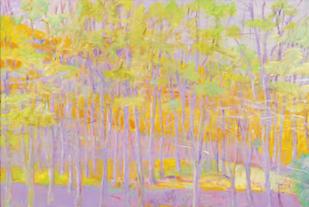Wolf Kahn
 Wolf Kahn’s well-balanced colorist technique of depicting landscapes has made him one of the most influential American artists of our generation. A native of Stuttgart, Germany, he attended the Hans Hofmann School of Fine Arts in New York City. It was here that he and a group of young artists, under the direction of Hans Hofmann, forged a style that was both representational and Abstract Expressionistic. Hans Hofmann’s didactic artistic theories proved to be one of the most significant influences upon Kahn’s work.
Wolf Kahn’s well-balanced colorist technique of depicting landscapes has made him one of the most influential American artists of our generation. A native of Stuttgart, Germany, he attended the Hans Hofmann School of Fine Arts in New York City. It was here that he and a group of young artists, under the direction of Hans Hofmann, forged a style that was both representational and Abstract Expressionistic. Hans Hofmann’s didactic artistic theories proved to be one of the most significant influences upon Kahn’s work.
In his own words, “We who studied with Hofmann felt ourselves to be the bearers of a more profound message, one better suited to give content and weight to the calling of ‘artist.’ We felt we were learning the essence of modernism, art stripped of everything extraneous. What remained was its esthetic/philosophical foundation, its raison d’être.” These progressive artists included Nell Blaine, Jane Freilicher, Allan Kaprow, Jan Muller, and Larry Rivers. They adopted Abstract Expressionistic spontaneity with the idea that the finished piece was an accumulated history of a process, a visual representation of energetic action and reaction. His influences and inspiration can be found in the works of such European artists as Braque, Bonnard, Soutine, and Van Gogh. He embraced the ideas of the Old Masters as well as those of Impressionism, Expressionism, and Post-Impressionism.
Kahn formulated a unique way in which he would employ simplified geometric designs while carefully contrasting numerous colors and tones. Whether it is his landscapes, which he was most recognized for, or his portraits, one may, upon inspection, feel paradoxical feelings of tranquility and brute emotion. With studios in both New York and Vermont, Kahn was able to draw his artistic inspiration from scenes in nature. His paintings are illuminating and beautiful, the colors striking and rich, the process intimately apparent to the observer. Kahn’s intuitive sense of color and dedicated pursuit of a new and sincere vision led to moments of youthful pleasure while others appeared delicate, ostensibly capturing the essence of the atmosphere.
Collections:
National Museum of American Art
Boston Museum of Fine Arts
The Brooklyn Museum of Art
Jewish Museum
Metropolitan Museum of Art
Museum of Modern Art
Whitney Museum
Museum of Fine Arts, Houston
Exhibitions:
Hansa Gallery, 1952-53, 1955
Borgenicht gallery, 1956, 1959, 1967
Seligmann Gallery, 1947
“813 Broadway”, 1950
Stable Gallery, 1954-5
Whitney Museum, 1960
Awards:
Guggenheim Fellowship, 1967